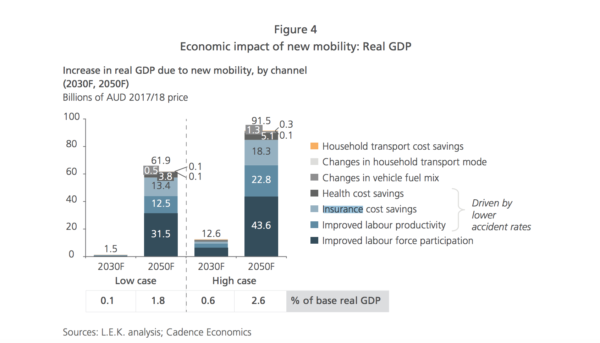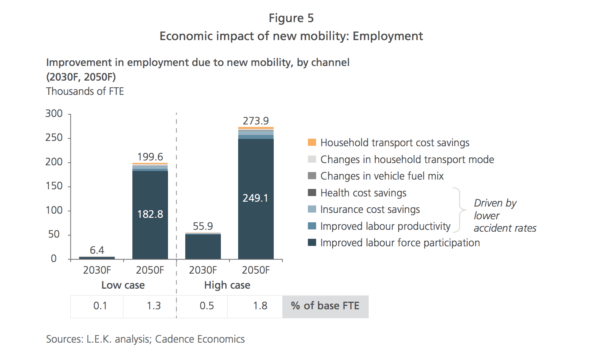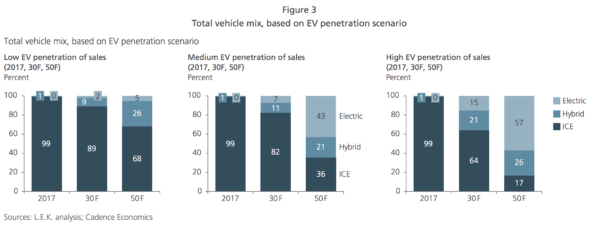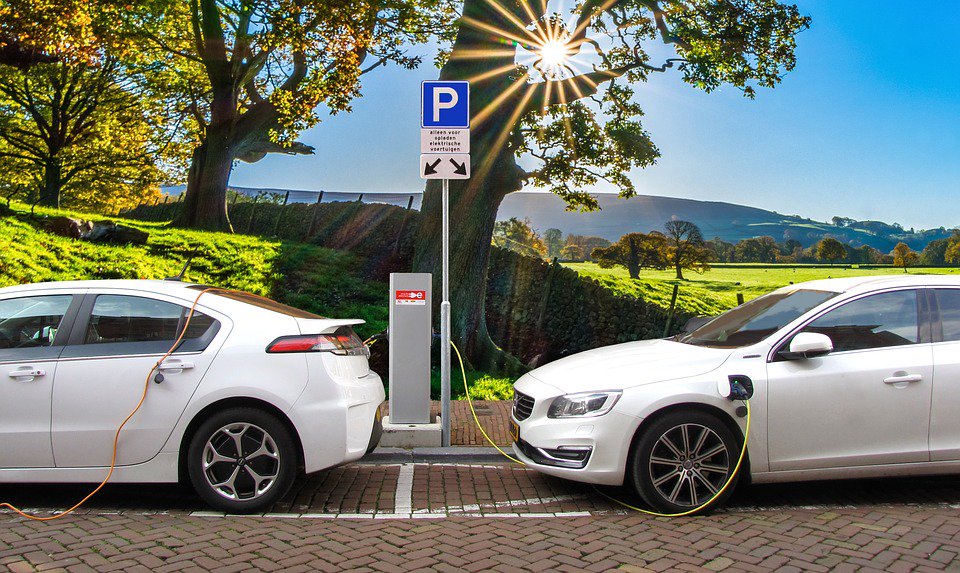Improved ease of transportation that leads to greater workforce participation, fewer road casualties and household savings in fuel bills are some of the knock-on effects — call them bumper-to-bumper bonuses — that are expected to flow from forecast uptake of electric vehicles (EVs) and autonomous vehicles (AVs), and other new mobility options according to a new study released today by management consultancy LEK Consulting.
The key finding of the report Economic benefits of new mobility for Australia, is that, “New mobility is likely to have a strong, positive impact on the Australian economy, raising real GDP by AUD$62 billion to AUD$92 billion, or 2%-3%, by 2050.”
Report author Mark Streeting, Partner at LEK told pv magazine, “When we started this piece of work we weren’t clear on whether the impact would be positive or negative to the economy overall, and we didn’t have any preconceived ideas on the scale of the impact,” but he new the outcomes would be “material” to business and government decisions and policy making.

Screenshot from report and uploaded by Natalie Filatoff on 12/8/19
Personalised transport will change everything
“New mobility” in this instance encompasses not only the forecast increase in EV and AV penetration, but ride-sharing options such as GoGet and PopCar; personalised mobility-as-a-service platforms (MaaS), such as Whim which operates in some European cities and combines public and other transportation services in one handy pay-as-you-go app; and ride sharing as is available through Uber and Ola.
What a difference accessible, lower-cost transport makes.The combined effect of these changes to transport accessibility and flexibility — the personalised approach to transportation needs — has the potential to reduce or even eliminate barriers to labour force participation, and thereby increase the size of the Australian labour force by “200,000-274,000 full-time equivalents, or about 1%-2%,” says the report.
Correlation with ABS survey data suggests AVs might enhance job access for up to 7.5% of underemployed and unemployed people — some 3.7% of whom gave the main difficulty in finding work as being: “too far to travel / transport problems”.

Image: LEK Consulting and Cadence Economics
Streeting told pv magazine, “We’re unlocking opportunities for enhanced mobility not only for the general population, but importantly for the transport disadvantaged, including those with disabilities.”
At least $30 billion benefit in reduced vehicle casualties
According to the report, AVs in particular are set to reduce human error and decrease road accidents by up to 70%, thereby again enhancing productivity otherwise affected by inability to work; reducing healthcare and health-insurance costs; and reducing the impact of loss of income due to inability to work.
This welcome reduction in accident rates translates into real GDP improvements of between AUD$30 billion to AUD$46 billion by 2050. Improved labour productivity and lower insurance costs will account for 87%-89% of this GDP increase.
Streeting says one can assume that all AVs — the robo-taxis and shared rides — will be EVs. “EVs are upon us.” he says. “We’re close to mass market, affordable models, but let’s be clear, it will take time because we only replace five percent of our vehicle fleet every year, so unless we’re going to have some significant intervention to drive the accelerated replacement of the fleet, the simple maths tells you it takes 20 years to turn over the whole private-vehicle fleet.”

Graph: LEK Consulting and Cadence Economics
Another recent report by energy analysts Cornwall Insight found that eight out of 13 major car manufacturers are collaborating to lower the costs and risks of EV development — a trend that is expected to result in a boom in global supply of lower-priced electric vehicles in the early 2020s.
These models are all anticipated to offer greater range per kilowatt than current models, and at the same time charging networks are gradually rolling out across Australia in anticipation of demand. In July, Chargefox, Australia’s only public EV charging network, had more than 300 public chargers available around Australia and four ultra-rapid-charge stations on Australia’s longest, most populous, east-coast route.
LEK projections do suggest that in Australia, “high penetration of EV sales could cause the internal combustion engine to fall to as little as 17% of the car market by 2050, compared with 99% in 2017”, thereby dramatically shifting reliance on petrol as a fuel. Although the expectation is that residential rooftop PV and a renewably energised grid will replace petrol with clean, free-to-low-cost electricity, Streeting says, “We need to be mindful of the source of that electricity.”
The subtleties of economic modelling
Streeting emphasises that the LEK analysis is indicative only, based on a number of assumptions and cross-referenced data points; and scenarios of low and high rates of adoption of new transport modes. The figures were arrived at via scenario analysis using a computable general equilibrium (CGE) model developed by Cadence Economics.
In the report he writes, “There remain many unknowns and variables. The impact of disruptive technologies is notoriously difficult to forecast, and new mobility innovations such as AVs and EVs have still to overcome significant hurdles to widespread adoption, such as regulatory approval and infrastructure development.”
The report concludes, however, that the potential economic benefits should drive businesses and governments to waste no time in planning for Australia’s future under new mobility.
This content is protected by copyright and may not be reused. If you want to cooperate with us and would like to reuse some of our content, please contact: editors@pv-magazine.com.









1 comment
By submitting this form you agree to pv magazine using your data for the purposes of publishing your comment.
Your personal data will only be disclosed or otherwise transmitted to third parties for the purposes of spam filtering or if this is necessary for technical maintenance of the website. Any other transfer to third parties will not take place unless this is justified on the basis of applicable data protection regulations or if pv magazine is legally obliged to do so.
You may revoke this consent at any time with effect for the future, in which case your personal data will be deleted immediately. Otherwise, your data will be deleted if pv magazine has processed your request or the purpose of data storage is fulfilled.
Further information on data privacy can be found in our Data Protection Policy.